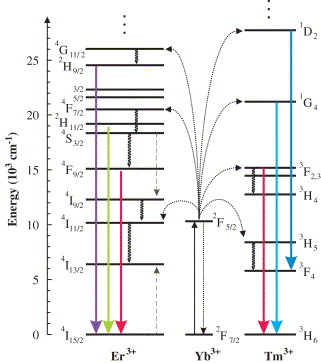Abstract of Publication No. 540
 J. F. Suyver, J. Grimm, M. K. van Veen, D. Biner, K. W. Krämer and H. U. Güdel
J. F. Suyver, J. Grimm, M. K. van Veen, D. Biner, K. W. Krämer and H. U. Güdel
Upconversion spectroscopy and properties of NaYF4 doped with
Er3+, Tm3+ and/or Yb3+
J. Lumin. 117, 1-12 (2006)
![]()
![]()
Abstract:
A spectroscopic investigation of NaYF4 powders doped with several
different concentrations of Er3+,
Tm3+
and/or Yb3+
is described. Rare earth-doped NaYF4 is known to be a very efficient
near-infrared to visible upconverter. The overview emission spectra for all
samples are presented and from these the upconversion efficiency is calculated.
Raman spectroscopy of undoped NaYF4 is presented here for the first
time, demonstrating that the dominant phonon modes in NaYF4 lie
between 300 and 400 cm–1. The fact that these phonon modes are
also the optically active ones is further demonstrated by temperature-dependent
excitation spectroscopy. These surprisingly low-energy phonon modes explain the
extraordinarily high upconversion efficiency of the rare earth-doped
NaYF4 samples. Excitation spectroscopy up to
![]() 70000 cm–1
in an NaErF4 sample reveals a
multitude of Er3+
4f excitations, including the illustrious 2F(2)5/2 one
that has not been observed in excitation spectroscopy before. From the
low-temperature power-dependence of the emission intensities for an Er3+,
Yb3+ codoped NaYF4 sample, it is concluded that the dominant upconversion
mechanism at low temperature is a different one than at room temperature. From
direct excitation, the lifetimes of the Yb3+ 2F5/2
70000 cm–1
in an NaErF4 sample reveals a
multitude of Er3+
4f excitations, including the illustrious 2F(2)5/2 one
that has not been observed in excitation spectroscopy before. From the
low-temperature power-dependence of the emission intensities for an Er3+,
Yb3+ codoped NaYF4 sample, it is concluded that the dominant upconversion
mechanism at low temperature is a different one than at room temperature. From
direct excitation, the lifetimes of the Yb3+ 2F5/2
![]() 2F7/2,
Er3+ 4F9/2
2F7/2,
Er3+ 4F9/2
![]() 4I15/2 and
Er3+ 4S3/2
4I15/2 and
Er3+ 4S3/2
![]() çI15/2
emissions are determined as a function
of temperature for all samples. At elevated temperatures, a significant decrease
in the green lifetime is observed, which is correlated to a simultaneous
quenching in the luminescence intensity. This quenching is ascribed to
cross-relaxation between two nearby Er3+
ions.
çI15/2
emissions are determined as a function
of temperature for all samples. At elevated temperatures, a significant decrease
in the green lifetime is observed, which is correlated to a simultaneous
quenching in the luminescence intensity. This quenching is ascribed to
cross-relaxation between two nearby Er3+
ions.